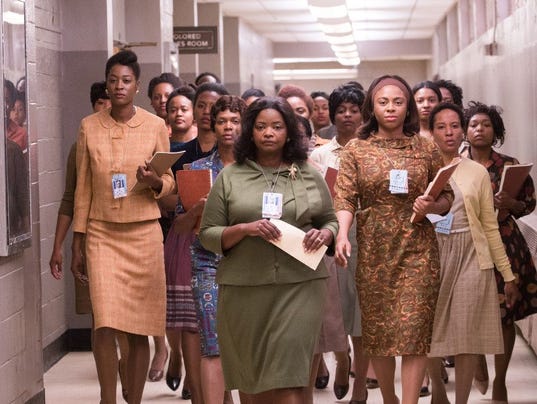The Trump Takeaway Behind the Movie, Hidden Figures
Ever so often a film comes out that
carries more meaning, more weight, more value than any other films
regardless of its genre. Such is the case of the movie, Hidden
Figures, the true story about three black American women working for
the National Aeronautic Space Administration (NASA) during the early
part of the 1960's. The women, Katherine Johnson, Dorothy Vaughan
and Mary Jackson, played respectively by Taraji P. Henson, Octavia
Spencer and Janelle Monae, were the women who were in a collective
with other black American women in NASA's computer service pool that
many of them were support personnel for their white contemporaries.
Jackson, Vaughan and Johnson were the exceptional ones. They had
become the standard bearers to a whole other world that black women
were not suppose to be a part of and that was in the field of science
and mathematics. They were the unrecognized heroes during the
heyday of the space race between the Soviet Union and the United
States. But before the film jumped to this time frame, it first took
us back to an earlier time of a younger Katherine Johnson nay
Katherine Coleman, when she was an eight or ten year old child.

The younger Katherine, played
graciously by Lidya Jewett, explores a time in our history and with
black youth that is total unrecognizable and foreign to the senses.
We get to witness the younger version of Katherine having this gift
for math and geometry. 

What is also remarkable is seeing how the
class reacts to her prowess as a mathematician. There was no snide
comments , bitterness or pettiness we've come to expect with this
generation of Twitter battles over the most stupid and agonizingly
insipid things. Of course you also had to accept the fact that it
was in the late 1920's and pettiness wasn't born into black culture
then. Blacks were dealing with the Jim Crow laws that were
oppressing many blacks during that time. But still, the behavior is
what I took away from that scene. There was truly a sense of wonder
because the vehicle in that scene was about attaining one's
education. It was a moment where you would mourn for the loss to
knowledge that today's youth just don't have a tolerance for and
would rather have the heads bent forward into their smartphones or
tablets.
Fast forward and Katherine is a widowed
mother of three girls in 1961. She, along with her two cohorts, are
broke down on the road to work and a white police officer pulls up
and harass them just to flex his authority. Mary Jackson, the more
vocally assertive of the three, wants to push back on the
authoritarianism but the other two encourage her to restrain her
efforts and she takes a more submissive tone with the police officer.
And as she does, the tone shifts a bit from a viewer's point of
view. This scene represents the first symbol of racism, the bigoted
white police officer flexing his power as he laud over three black
women. But this racism is diffused by all three women who allow
themselves to be humble in his presence and not escalate the
situation and they do so effectively by demonstrating their
intelligence in very subtle tones. And as I watched this scene, I
felt a twinge of moral outrage that even though this happened so many
years ago, the impact still hold a weight on your consciousness.

As we start to get into the heart of
the film, Katherine is selected to do mathematical computations as a
backup to the other NASA scientist just to provide a security backup
in the initial limited capacity that was doled out to her. Under
redacted reports, her job became frustrating as she could not fully
perform the assignment that was given to her. Compounding this
effort was the fact that NASA had a policy of segregation within its
workforce. Restrooms and drinking fountains were assigned as
“colored” and “whites”. The only restroom Katherine could
use was a long way from where she was assigned and she had to trek a
great distance just to use the “colored” restrooms. This brings
up another racist vestige to the forefront, the specter of separating
the water fountains and the restrooms has more significance over
another. They same labeling was applied to the coffee pots as well
with the “colored” one not even being made ready for coffee. But
I must remember that these were the times that they lived in.
Mary Jackson, the woman who would
become the first black female engineer at NASA had her share of
discrimination as well. There were policies in place that stated
that blacks, and especially a female black, could not advance to be
an engineer without certain qualifications even with a degree and she
held a Bachelor of Science degree. She had to sue to go back to high
school to earn the course curriculum needed in order for her to
become an engineer.

I was getting more incensed by the
moment with every racist slight these women endured. And I was
generally shocked that these women's story never graced the history
pages during my formative years and that other films like The Right Stuff, failed to give
them their acknowledgment and contribution to the space program. Two
of the three women have died without receiving any noteworthy praise
for their part in contributing to the NASA environment. And my
outrage grows.
Dorothy Vaughan role is NASA was just
as remarkable. With NASA's introduction of the IBM mainframe
computers of the time that were Fortran computer based language,
Dorothy had the foresight to learn the language and teach it to the
other women in the computer pool. As I watched her story, I couldn't
believe that even the public library was segregated. She had to
“appropriate”, I will not use the word 'steal', a book on the
Fortran language and she learned it all on her own without any
assistance or guidance from anyone.

And while NASA was and is a part of the
U.S. government, it was the first institution mandated to hire
minorities. And even though it did, racism and sexism still rule the
order of life. When Katherine made attempts to be included in the
proceedings with the NASA program, her gender played more against her
than her race. As she had each obstacle removed, the perceptions
were also removed when she demonstrated her ability to do the work.
She was a pioneer in that regard and every woman in the space program
have her to thank for that.
Keven Costner said that his role was an
amalgamation of several people so I do not know if there ever was a
person who took a crowbar and tore down the colored restroom sign or
that this person served as the metaphorical crowbar for Katherine
Johnson to get through those doors. If there ever was such a real
person, they should acknowledge him as being a contributing agent
because one person does not go into battle alone.

So, what does this film about three
black American women have to do with Donald Trump? In a nutshell, it
has a lot to with with being disappointed and facing stumbling blocks
and doing what you have to do and persevering in spite of your
circumstances. I find it interesting that mostly the liberal white
Americans are losing their mind over Trump's victory in the general
election. There have been protests, fights, smear tactics and the
like over his election to the highest office in the land. And as I
watched this film, I began to put it into a perspective that perhaps
the liberal white Americans should accept and acknowledge. For a
long time in the history of this country, minorities have accepted
the brunt of social ills for generations. It took 55 years for us to
hear about this remarkable achievement of three minority women in the
space program and yet a film entitled Sid & Nancy, about punk
rockers Sid Vicious and his girlfriend, Nancy Spungen, was made five
years after his death.
The minority community have come to
accept the dysfunctional, apathetic, disenfranchising, maligning
approach to what is considered fairness in this country. Donald
Trump, a billionaire, won over Hillary Clinton, a millionaire. So
why are the white liberals losing their minds over this? Perhaps
because they do not understand what it feels like to be on the losing
in for so many things. They don't know how to accept defeat in such
glorious terms. Everyone ones to point blame at this or that and
totally ignore the root cause to their defeat. They need to
understand what it means to be a person of color. They need to take
a cue from Barack Obama, from Deepak Chopra, from Cesar Chavez, from
Booker T. Washington, from Madame C.J. Walker, from Rita Morena,
people who understand what the obstacles are from being a person of
color in America and what it took to overcome those barriers. And
just because people of color have been forced to deal with these
barriers, it does not mean that all hope is lost, it just mean that
another approach needs to be made in order to overcome these
barriers.
President Obama had to prove everyday
to the American people and to the conservative arm of Congress that
he was entitled to the job and he had to work twice as hard to prove
it. This perception and attitude is with every person of color. It
is the unwritten rule that is never discussed in polite company but
it is always there underneath every thing that is expected with a
person of color and this is reflected in quiet tomes in the film.
When Katherine Johnson finally explodes
in the film about what she has to do to get to the restroom, it was
something her white counterparts couldn't fathom doing and wouldn't
do if the situation were on the other foot. This slice represents
more than just a bathroom break, it represents the nature of what
people of color endure. So Hillary lost and Donald won, get over
yourselves. The country wasn't founded on a bunch of whiners. We
have other better things to do, to accomplish, as did these women.
These were real American women who happened to be black and who faced
racism and misogyny and sexism and took it with their heads held
high. Why can't we learn from them?

No comments:
Post a Comment